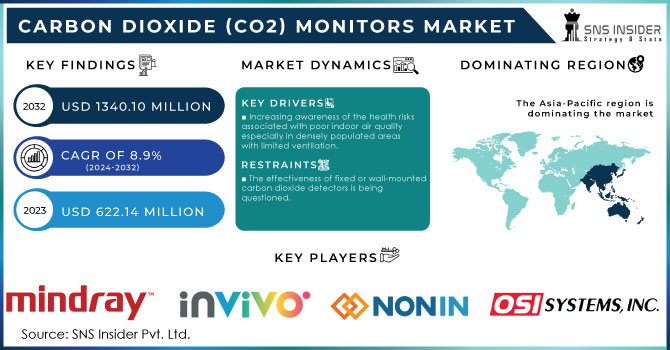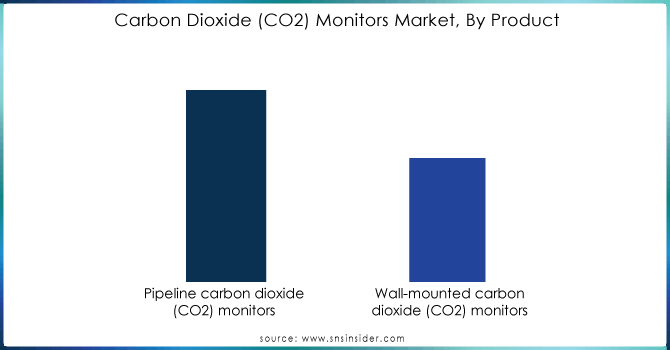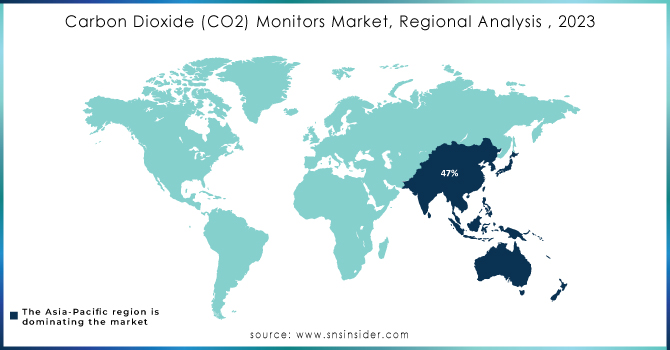Carbon Dioxide (CO2) Monitors Market Size:

Get more information on Carbon Dioxide (CO2) Monitors Market - Request Sample Report
The Carbon Dioxide (CO2) Monitors Market Size was valued at USD 622.14 million in 2023, and is expected to reach USD 1340.10 million by 2032, and grow at a CAGR of 8.9% over the forecast period 2024-2032
The carbon dioxide monitor market is experiencing growth due to a number of reasons coming together. Rising awareness of indoor air quality and its link to health issues is a key driver particularly in regions with a growing geriatric population.
Poor ventilation in modern space-saving buildings further increases the need for CO2 monitors. These devices not only detect dangerous gas levels but also offer valuable data for maintaining a healthy environment critical for children who are more susceptible to CO2's effects. Technological advancements are another key driver of growth in the carbon dioxide monitor market. The integration of CO2 monitors with smart building systems allows for real-time monitoring and adjustments to ventilation based on CO2 readings. This creates a feedback loop that optimizes indoor air quality and energy efficiency. CO2 monitors are incorporating advanced sensors and Internet of Things (IoT) connectivity enabling them to collect and transmit data to cloud platforms for further analysis. This data can be used to identify trends predict future CO2 levels and automate building controls to proactively maintain a healthy environment. Governments are playing a role in this market expansion through initiatives promoting clean air and sustainable development. Stringent regulations on air quality particularly in North America are driving demand for CO2 monitors. This trend coupled with growing awareness and technological innovation suggests a bright future for the carbon dioxide monitor market.
Carbon Dioxide (CO2) Monitors Market Dynamics:
KEY DRIVERS:
-
Increasing awareness of the health risks associated with poor indoor air quality especially in densely populated areas with limited ventilation.
-
The vulnerability of children to CO2 exposure making early detection through CO2 monitors crucial for their health.
The CO2 monitor market is rising due to growing awareness of indoor air quality concerns. Poor ventilation in modern buildings and rising urbanization are driving demand for these devices, which can detect dangerous CO2 levels and improve health outcomes, especially for children. The advancements like real-time alerts and integration with smart building systems are further increasing the market need for CO2 monitors.
RESTRAINTS:
-
Two potential barriers to wider adoption of carbon dioxide monitors could be limited public understanding of their benefits and the initial expense of purchasing and maintaining these devices.
-
The effectiveness of fixed or wall-mounted carbon dioxide detectors is being questioned.
OPPORTUNITIES:
-
The demand for CO2 monitors is going up very fast in workplaces and educational settings like enclosed offices, schools and classrooms.
-
The increasing number of elderly citizens and a growing appreciation for the role these devices play in maintaining healthy air quality.
The CO2 monitor market is experiencing a which demand driven by multiple factors. Growing concerns about indoor air quality particularly in schools, offices and classrooms are prompting increased adoption. A rising elderly population and stricter regulations like California's AB 841 mandate CO2 monitor use in specific settings. The potential of CO2 monitors to curb airborne illness transmission is fueling further market growth. This confluence of factors suggests a significant rise in CO2 monitor requirements in the coming years.
CHALLENGES:
-
Ensuring CO2 monitor effectiveness might require improved training programs for those using the devices.
-
The increasing availability of CO2 detectors at lower price points.
IMPACT OF RUSSIA-UKRAINE WAR
The war between Russia & Ukraine is causing a lot of problems around the world but it probably won't change the CO2 monitor market much. Even though the war is making energy more expensive and everyone's worried about different things now CO2 monitors are still needed in lots of places like hospitals, beer makers, greenhouses and more. These places will likely keep using CO2 monitors no matter how expensive energy gets because of the war. A bigger impact of the war might be on countries fighting over resources as the ice caps melt. This could potentially make it harder to get the materials needed to build CO2 monitors but it depends on exactly what materials are needed and what happens between these countries.
The war probably won't have a big direct impact on the CO2 monitor market. But it could make it harder to get the things needed to build them in the future.
IMPACT OF ECONOMIC SLOWDOWN
The economic slowdown's impact on the CO2 monitor market is uncertain and depends on various factors. When times are tough for businesses especially smaller ones might be less likely to spend money on new things like these monitors. A general pullback in spending could cause demand to drop across various sectors. Economic downturns often spark a focus on saving money and CO2 monitors can help optimize energy use in buildings making them more attractive. The sectors like hospitals and research which rely heavily on CO2 monitors might see more stable demand during a slowdown the impact is uncertain. While some sectors might face challenges a focus on cost-efficiency could lead to more affordable CO2 monitors potentially expanding the market in the long run.
Carbon Dioxide (CO2) Monitors Market Segment Overview:
By Product
Wall-mounted CO2 monitors are the current leader in the market holding a significant share of over 59% valued at $0.2 billion in forecast period. This dominance is due to their suitability for quick and easy CO2 level checks across various industries. This convenience is a major factor driving the overall growth of the CO2 monitor market. In simpler terms most CO2 monitors used today are wall-mounted because they're easy to use for quick checks in many different workplaces. This popularity is a big reason why the entire CO2 monitor market is growing.

Get Customized Report as per your Business Requirement - Request For Customized Report
By Application
More than half over 56% of all CO2 monitors are used in breweries to make sure their beer has just the right amount of bubbles. This is because controlling the CO2 is very important for brewing beer. But hospitals are catching up quickly because more and more people are having trouble breathing hospitals and other medical places are expected to be the part of the market that grows the fastest. Even though breweries are dominat right now hospitals might be the future winner of the CO2 monitor game.
Carbon Dioxide (CO2) Monitors Market Regional Analysis:
The Asia-Pacific (APAC) region currently dominates the CO2 monitor market holding a significant share of 47%. This dominance can be attributed to the increasing number of respiratory illnesses in this region. The North America have a big and successful market for monitoring environmental conditions and ensuring healthy indoor air quality. A growing public understanding of the health risks associated with poor air stricter regulations and a rising focus on environmental responsibility are all driving the demand for CO2 monitors in this region. North America benefits from a strong presence of leading CO2 monitor manufacturers cutting-edge research institutions and continuous technological advancements all of which contribute to the market's continued expansion.

KEY PLAYERS:
The key players in the Carbon Dioxide (CO2) market are OSI Systems, Criticare Systems, Invivo, Mindray North America, Nonin Medical, Radiometer Medical, Thames Medical, GE Healthcare, Masimo, Nihon Kohden Corporation, Philips Healthcare, Smiths Medical & Other Players.
RECENT DEVELOPMENTS:
In June 2023: Philips teamed up with Masimo to upgrade their IntelliVue patient monitors. Now these monitors can measure sedation levels blood oxygenation in the brain and even CO2 levels all in one machine. This is a big improvement because it gives doctors a more complete picture of a patient's health.
In June 2022: GE and Medtronic got the green light to combine advanced CO2 and oxygen monitors into one system. This lets doctors track patients better, both in the room and on the move, potentially improving care and safety.
| Report Attributes | Details |
|---|---|
| Market Size in 2023 | USD 622.14 Million |
| Market Size by 2032 | USD 1340.10 Million |
| CAGR | CAGR of 8.9% From 2024 to 2032 |
| Base Year | 2023 |
| Forecast Period | 2024-2032 |
| Historical Data | 2020-2022 |
| Report Scope & Coverage | Market Size, Segments Analysis, Competitive Landscape, Regional Analysis, DROC & SWOT Analysis, Forecast Outlook |
| Key Segments | • By Type (Transcutaneous Carbon Dioxide (Tcpco2) Monitors, End-Tidal Carbon Dioxide (Etco2) Monitors) • By Product (Pipeline Carbon Dioxide (CO2) Monitors, Wall-Mounted Carbon Dioxide (CO2) Monitors) • By Application (Hospital Use, Breweries, Underground Car Parks, Scientific Research, Greenhouses, Office Buildings, Others) |
| Regional Analysis/Coverage | North America (US, Canada, Mexico), Europe (Eastern Europe [Poland, Romania, Hungary, Turkey, Rest of Eastern Europe] Western Europe] Germany, France, UK, Italy, Spain, Netherlands, Switzerland, Austria, Rest of Western Europe]), Asia Pacific (China, India, Japan, South Korea, Vietnam, Singapore, Australia, Rest of Asia Pacific), Middle East & Africa (Middle East [UAE, Egypt, Saudi Arabia, Qatar, Rest of Middle East], Africa [Nigeria, South Africa, Rest of Africa], Latin America (Brazil, Argentina, Colombia, Rest of Latin America) |
| Company Profiles | OSI Systems, Criticare Systems, Invivo, Mindray North America, Nonin Medical, Radiometer Medical, Thames Medical, GE Healthcare, Masimo, Nihon Kohden Corporation, Philips Healthcare and Smiths Medical. |
| Key Drivers | • Increasing awareness of the health risks associated with poor indoor air quality especially in densely populated areas with limited ventilation. • The vulnerability of children to CO2 exposure making early detection through CO2 monitors crucial for their health. |
| Restraints | • Two potential barriers to wider adoption of carbon dioxide monitors could be limited public understanding of their benefits and the initial expense of purchasing and maintaining these devices. • The effectiveness of fixed or wall-mounted carbon dioxide detectors is being questioned. |

